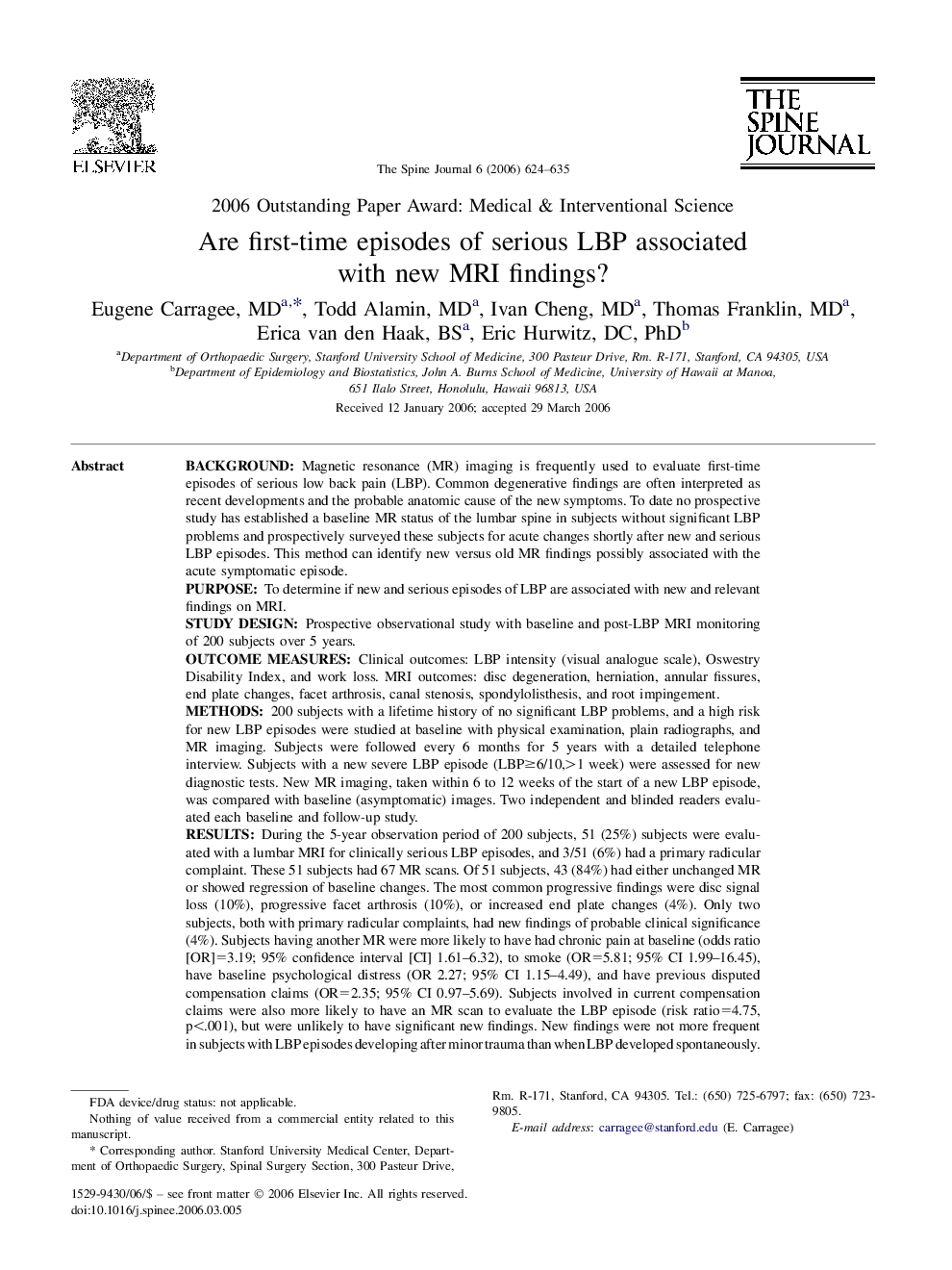| کد مقاله | کد نشریه | سال انتشار | مقاله انگلیسی | نسخه تمام متن |
|---|---|---|---|---|
| 4100118 | 1268671 | 2006 | 12 صفحه PDF | دانلود رایگان |

BackgroundMagnetic resonance (MR) imaging is frequently used to evaluate first-time episodes of serious low back pain (LBP). Common degenerative findings are often interpreted as recent developments and the probable anatomic cause of the new symptoms. To date no prospective study has established a baseline MR status of the lumbar spine in subjects without significant LBP problems and prospectively surveyed these subjects for acute changes shortly after new and serious LBP episodes. This method can identify new versus old MR findings possibly associated with the acute symptomatic episode.PurposeTo determine if new and serious episodes of LBP are associated with new and relevant findings on MRI.Study designProspective observational study with baseline and post-LBP MRI monitoring of 200 subjects over 5 years.Outcome measuresClinical outcomes: LBP intensity (visual analogue scale), Oswestry Disability Index, and work loss. MRI outcomes: disc degeneration, herniation, annular fissures, end plate changes, facet arthrosis, canal stenosis, spondylolisthesis, and root impingement.Methods200 subjects with a lifetime history of no significant LBP problems, and a high risk for new LBP episodes were studied at baseline with physical examination, plain radiographs, and MR imaging. Subjects were followed every 6 months for 5 years with a detailed telephone interview. Subjects with a new severe LBP episode (LBP≥6/10,>1 week) were assessed for new diagnostic tests. New MR imaging, taken within 6 to 12 weeks of the start of a new LBP episode, was compared with baseline (asymptomatic) images. Two independent and blinded readers evaluated each baseline and follow-up study.ResultsDuring the 5-year observation period of 200 subjects, 51 (25%) subjects were evaluated with a lumbar MRI for clinically serious LBP episodes, and 3/51 (6%) had a primary radicular complaint. These 51 subjects had 67 MR scans. Of 51 subjects, 43 (84%) had either unchanged MR or showed regression of baseline changes. The most common progressive findings were disc signal loss (10%), progressive facet arthrosis (10%), or increased end plate changes (4%). Only two subjects, both with primary radicular complaints, had new findings of probable clinical significance (4%). Subjects having another MR were more likely to have had chronic pain at baseline (odds ratio [OR]=3.19; 95% confidence interval [CI] 1.61–6.32), to smoke (OR=5.81; 95% CI 1.99–16.45), have baseline psychological distress (OR 2.27; 95% CI 1.15–4.49), and have previous disputed compensation claims (OR=2.35; 95% CI 0.97–5.69). Subjects involved in current compensation claims were also more likely to have an MR scan to evaluate the LBP episode (risk ratio=4.75, p<.001), but were unlikely to have significant new findings. New findings were not more frequent in subjects with LBP episodes developing after minor trauma than when LBP developed spontaneously.ConclusionFindings on MR imaging within 12 weeks of serious LBP inception are highly unlikely to represent any new structural change. Most new changes (loss of disc signal, facet arthrosis, and end plate signal changes) represent progressive age changes not associated with acute events. Primary radicular syndromes may have new root compression findings associated with root irritation.
Journal: The Spine Journal - Volume 6, Issue 6, November–December 2006, Pages 624–635